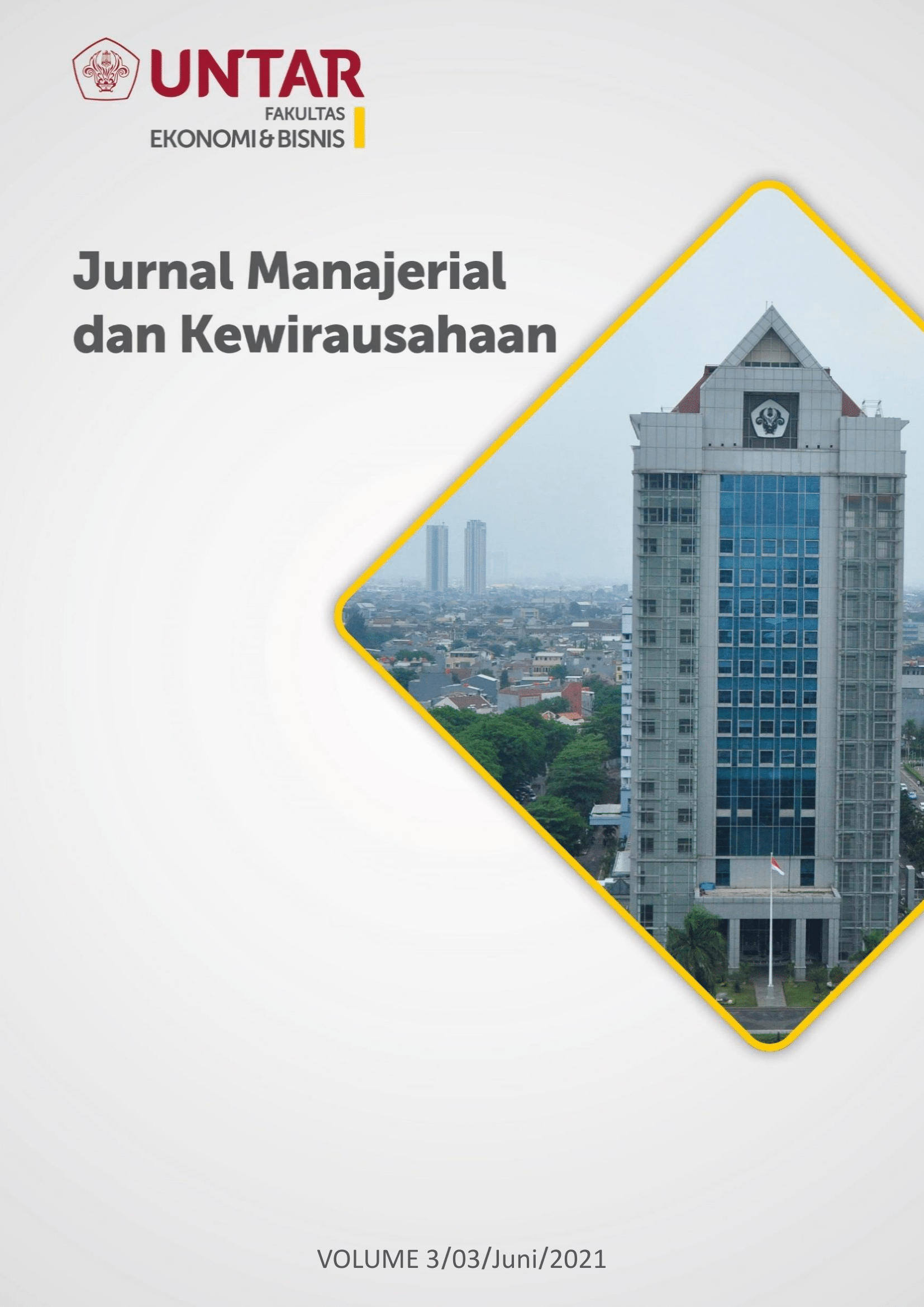Faktor-Faktor Yang Mempengaruhi Kepuasan Keuangan Mahasiswa/I Universitas Tarumanagara
Main Article Content
Abstract
The purpose of this research is to analysis effect of Financial Knowledge, Financial Efficacy and Childhood Consumer Experience toward Financial Satisfaction on students of Tarumanagara University. Samples of this research where selected by non probability method with purposive technique sampling. The sample of this research using 150 respondents. The data collection technique was carried out using a questionnaire. Data were analyzed using SEM-PLS method with Smart PLS 3.3.3 application. The results of this study indicate that Financial Knowledge did not have a significant effect of Financial Satisfaction. Meanwhile, Financial Efficacy and Childhood Consumer Experience have a significant effect of Financial Satisfaction.
Penelitian ini bertujuan untuk mengetahui pengaruh pengetahuan keuangan, efikasi keuangan, dan pengalaman anak terhadap kepuasan keuangan pada Mahasiswa/i Universitas Tarumanagara. Pengumpulan sampel dilakukan dengan menggunakan metode nonprobability dengan menggunakan teknik purposive sampling. Sampel dari penelitian ini menggunakan sebanyak 150 responden. Teknik pengambilan data dilakukan dengan menggunakan kuesioner melalui google form. Data dianalisis menggunakan metode SEMPLS dengan aplikasi Smart PLS 3.3.3. Hasil yang didapatkan dari penelitian ini adalah Pengetahuan Keuangan tidak memiliki pengaruh signifikan terhadap Kepuasan Keuangan. Sedangkan Efikasi Keuangan dan Pengalaman Anak memiliki pengaruh signifikan terhadap Kepuasan Keuangan.
Article Details
This work is licensed under a Jurnal Muara Ilmu Ekonomi dan Bisnis Creative Commons Attribution-ShareAlike 4.0 International License.,/p>
References
Andani, Nidya Delvi. (2018). Pengaruh Income, Financial Knowledge, Financial Behavior dan Childhood Consumer Experience Terhadap Financial Satisfaction Pada Pegawai PT. Perusahaan Listrik Negara (Persero) Wilayah Sumatera Utara. Univesitas Sumatera Utara.
Arifin, Agus Zainul. (2018). Influence Factors toward Financial Satisfaction with Financial Behavior as Intervening Variable on Jakarta Area Workforce. European Research Studies Journal. 21(1), 90-103.
Brandon, D. P. & Smith, C. M. (2009). Prospective Teachers’ Financial Knowledge and Teaching Self-Efficacy. Journal of Family & Consumer Sciences Education, 27(1).
Candra, J. W., & Memarista, G. (2015). Faktor-Faktor yang Mempengaruhi Financial Satisfaction pada Mahasiswa Universitas Kristen Petra. FINESTA, 3(2), 1–6.
Chen, H. & Volpe, R.P. (1998). An Analysis of Personal Financial Literacy among College Students. Financial Services Review, 7(2), 107-128
Co?kuner, Selda. (2016). Understanding Factors Affecting Financial Satisfaction: The Influence of Financial Behavior, Financial Knowledge and Demographics. Imperial Journal of Interdisciplinary Research (IJIR), 2(5), 377-385.
Darmawan, D., & Pamungkas, A. S. (2019). Pengaruh Financial Attitude, Financial Behavior, Dan Financial Knowledge Terhadap Financial Satisfaction. Journal of Economic, Management and Accounting, 2(2), 9.
Durband, D. B., Law, R. H., and Mazzolini, A. K. (2019). Financial Counseling. Springer Nature Switzerland AG 2019.
Falahati, L., Sabri, M. F., & Paim, L. H. (2012). Assessment a model of financial satisfaction predictors: Examining the mediate effect of financial behavior and financial strain. World Applied Sciences Journal, 20(2), 190-197.
Fazli Sabri, M., Cook, C. C., & Gudmunson, C. G. (2012). Financial well? being of Malaysian college students. Asian Education and Development Studies, 1(2), 153– 170.
Finke, Chatterjee, S, M. & Harness, N. (2011). The impact of selfefficacy on wealth accumulation and portfolio choice. Applied Economics Letters. 18 (7), 627-631.
Garson, G. D. (2016). Partial Least Squares: Regression and Structural Equation Models. Asheboro, NC: Statistical Associates Publishers.
Hair Jr, J. F., Sarstedt, M., Hopkins, L., & G. Kuppelwieser, V. (2014). Partial least squares structural equation modeling (PLS-SEM) An emerging tool in business research. European Business Review, 26(2), 106-121.
Halim, Yopie Kurnia Erista & Astuti, Dewi. (2015). Financial Stressors, Financial Behavior, Risk Tolerance, Financial Solvency, Financial Knowledge, dan Kepuasan Finansial. FINESTA, 3(1), 19-23.
Henseler, J., Ringle, C. M., & Sarstedt, M. (2015). A new criterion for assessing discriminant validity in variance-based structural equation modeling. Journal of the academy of marketing science, 43(1), 115-135
Henseler, J., Ringle, C. M., & Sinkovics, R. R. (2009). The use of partial least squares path modeling in international marketing. In New challenges to international marketing. Emerald Group Publishing
Limited. Hira, T., & Mugenda, O. (1998). Predictors of Financial Satisfaction: Differences Between Retirees and Non Retirees. Journal Financial Conseling and Planning, 9(2), 75-48.
Joe F. Hair, Christian M. Ringle & Marko Sarstedt. (2011). PLS-SEM: Indeed a Silver Bullet. Journal of Marketing Theory and Practice Lown, J. M. (2011). Outstanding AFCPE® Conference Paper: Development and Validation of a Financial Self-Efficacy Scale. Journal of Financial Counseling and Planning, 22(2), 54-63.
Martin Wetzels, Gaby Odekerken-Schröder, Claudia van Oppen. (2009). Using PLS Path Modeling For Assessing Hierarchical Construct Models: Guidelines and Empirical Illustration. MIS Quarterly 33(1).
Pratiwi, O. (2019). Pengaruh Financial Knowledge, Financial Behavior, Financial Efficacy dan Risk Tolerance Terhadap Financial Satisfaction. Jurnal Dinamika Manajemen dan Bisnis, 2(2), 24-30
Sabri, M. F., Othman, M. A., Masud, J., Paim, L., MacDonald, M., & Hira, T. K. (2008). Financial behavior and problems among college students in Malaysia: Research and education implication. Consumer Interest Annual, 54, 166–170
Saurabh, K., & Nandan, T. (2018). Role of Financial Risk Attitude and Financial Behavior As Mediators In Financial Satisfaction. South Asian Journal of Business Studies, 7(2), 207–224.
Sina, P. (2014). Financial Efficacy dan Financial Satisfaction: Ditinjau dari Perbedaan Gender. Jurnal Manajemen Maranatha, 12(2).
Uma Sekaran and Roger Bougie. (2013). Research Methods for Business A Skill-Building Approach. Seventh edition. White, A. G. (2007). A Global Projection of Subjective Well-being: A Challenge To Positive Psychology? Psychtalk 56, 17-20.



